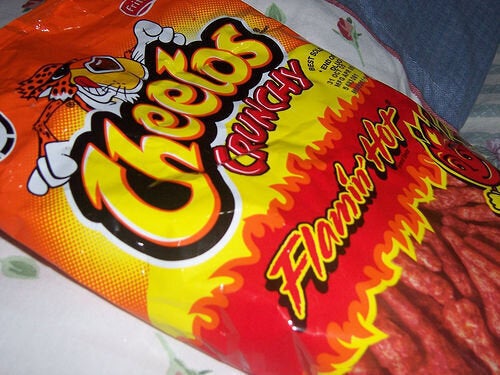
On my Houston ISD school food blog, The Spork Report, I once shared a candid photo of a Houston middle schooler's "lunch:" a bag of Baked Flamin' Hot Cheetos doused in cheesy nacho sauce:
Both of those items were purchased by the student from one of my district's cafeteria a la carte lines (to be accurate, I think HISD actually sells a "knock-off" brand of Baked Flamin' Hot Cheetos), and the photo caused a bit of an uproar here in Houston. It prompted many people, including one of our school board trustees, to ask: why are schools in the business of selling this sort of non-nutritive junk food in the first place?
So I was interested to read recently that various schools around the country -- in Pasadena, New Mexico and Illinois -- are banning Flamin' Hot Cheetos from their campuses. The reasons for the bans range from the product's poor nutritional value (26 grams of fat per bag for the non-baked version) to the fact that kids are leaving hard-to-clean, bright red fingerprints all over classrooms. (Ick.)
But Monica Eng of the Chicago Tribune who broke the story on Flamin' Hot Cheeto bans, also examines the potentially addictive properties of the product, a product which her interviewed expert describes as a "hyperpalatable" food.
"Hyperpalatablity" is a term first coined by Dr. David Kessler, former FDA Commissioner, who in 2010 wrote a provocative book describing the methods used by the food industry to stimulate demand for its products. According to Kessler, processed food companies and chain restaurants carefully calibrate fat, sugar and salt to trigger the brain's reward system, leading eaters to consume more and more of the food, often well past physical fullness, in a manner that resembles (or might actually be) an addiction.
When I first heard about Kessler's book, The End of Overeating, I totally pooh-poohed the notion of food addiction. Back then I felt that anyone complaining of a food addiction just lacked basic willpower and was looking for someone else to blame. But then I encountered a food product which sent my own synapses firing wildly, causing me to abandon all control. I wrote a semi-facetious post about that experience -- "My Love Affair With Stacy and What It's Doing to the Kids;" here's an excerpt:
These days, when I think no one in my family is looking, I like to slip discreetly into the pantry to pay Stacy a little visit. I'm in control here, I tell myself every time. I'm not going to let things go too far. But then later, many long, delicious moments later, I emerge from the pantry -- guilty, ashamed, and with salty crumbs all over my face and shirt that are as telltale as any lipstick on a collar. Yes, there will be an extra five pounds on my hips by the pool this summer, but that's a small price to pay for a love like this.
All kidding aside, what Stacy taught me is that all of us are potentially vulnerable to the potent allure of processed snacks. So what makes Flamin' Hot Cheetos so different from other junk food that it deserves its own special ban in schools?
My answer: nothing.
Yes, Flamin' Hots have an aura of "danger" which fuels their wild popularity with kids -- and which other food companies have shamelessly copied (e.g., here and here) -- but when it comes to "addictiveness" and to poor nutritional quality, one kid's Flaming Hot Cheetos is another kid's Cool Ranch Dorito. All of these snacks are quite deliberately designed to have that "betcha can't eat just one" quality and none of them contribute positively in any way to a child's diet.
And that returns us to the question posed at the outset: Why are schools in the business of selling this stuff?
That very question is about to become part of the national conversation when USDA soon releases proposed nutritional standards for "competitive" school food, i.e., all the foods and beverages sold in campus vending machines, cafeteria snack bars, at fundraisers and the like. My fear is that the processed food industry will exert its tremendous lobbying power to keep these regulations as weak as possible. Down the road we may no longer have chips with 26 grams of fat sold on school campuses, but I have little doubt we'll still see rejiggered, "lite" versions of these same products.
Is that really where we want to end up? Couldn't we do better? Is it remotely possible that Congress will follow the lead of San Francisco USD and require snack products sold on campus to not only be low in fat and salt but to also contain naturally-occurring positive nutrients? (That "naturally-occurring" qualifier is essential if we're to avoid the inevitable "Baked Flamin' Hot Cheetos -- now fortified with Vitamins B, C & E!").
When the proposed competitive food rules are released for comment, let's see what we can do to get our voices heard.
September 22, 2012: This post was corrected to cite the Chicago Tribune as the original source of the story regarding Flamin' Hot Cheeto bans